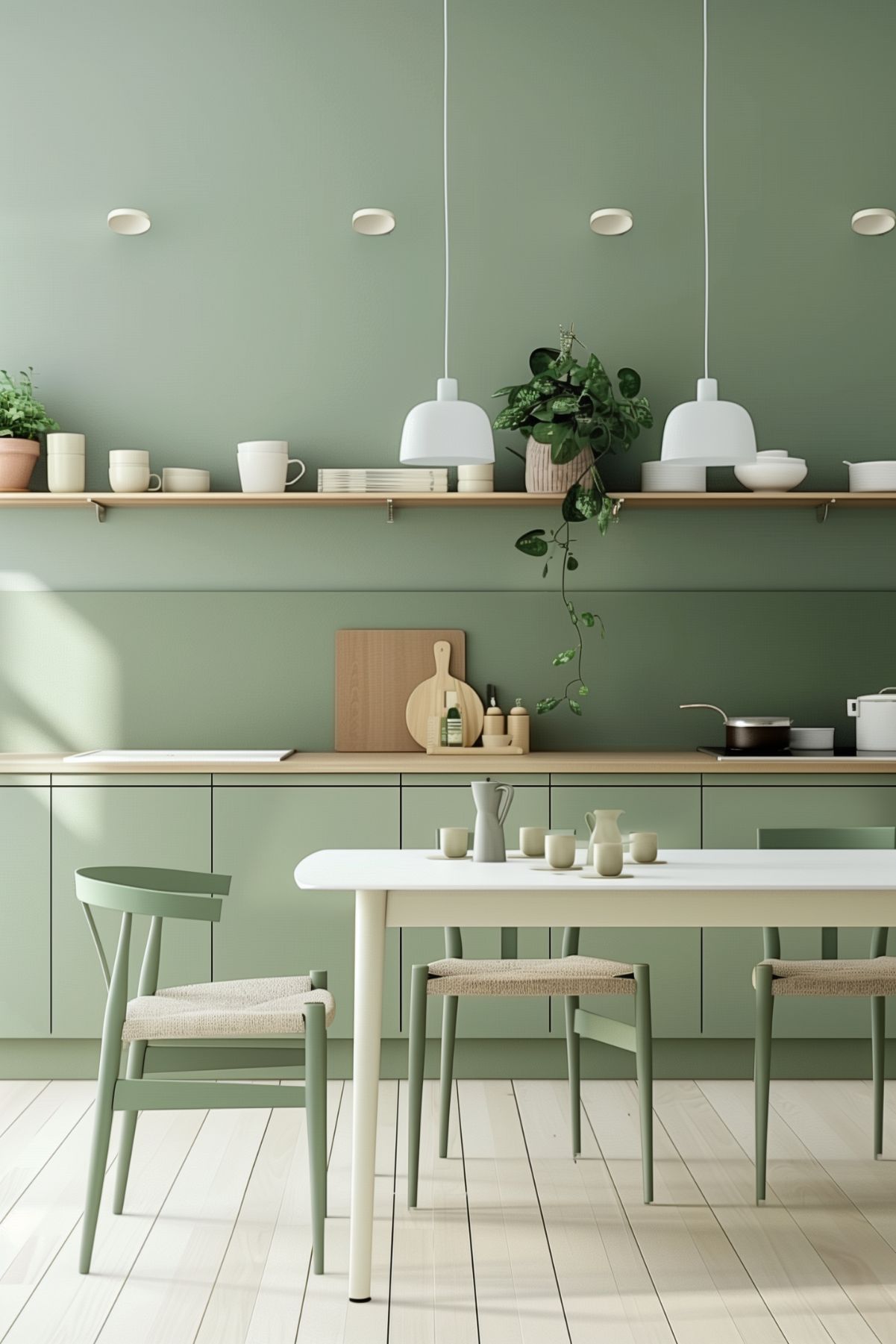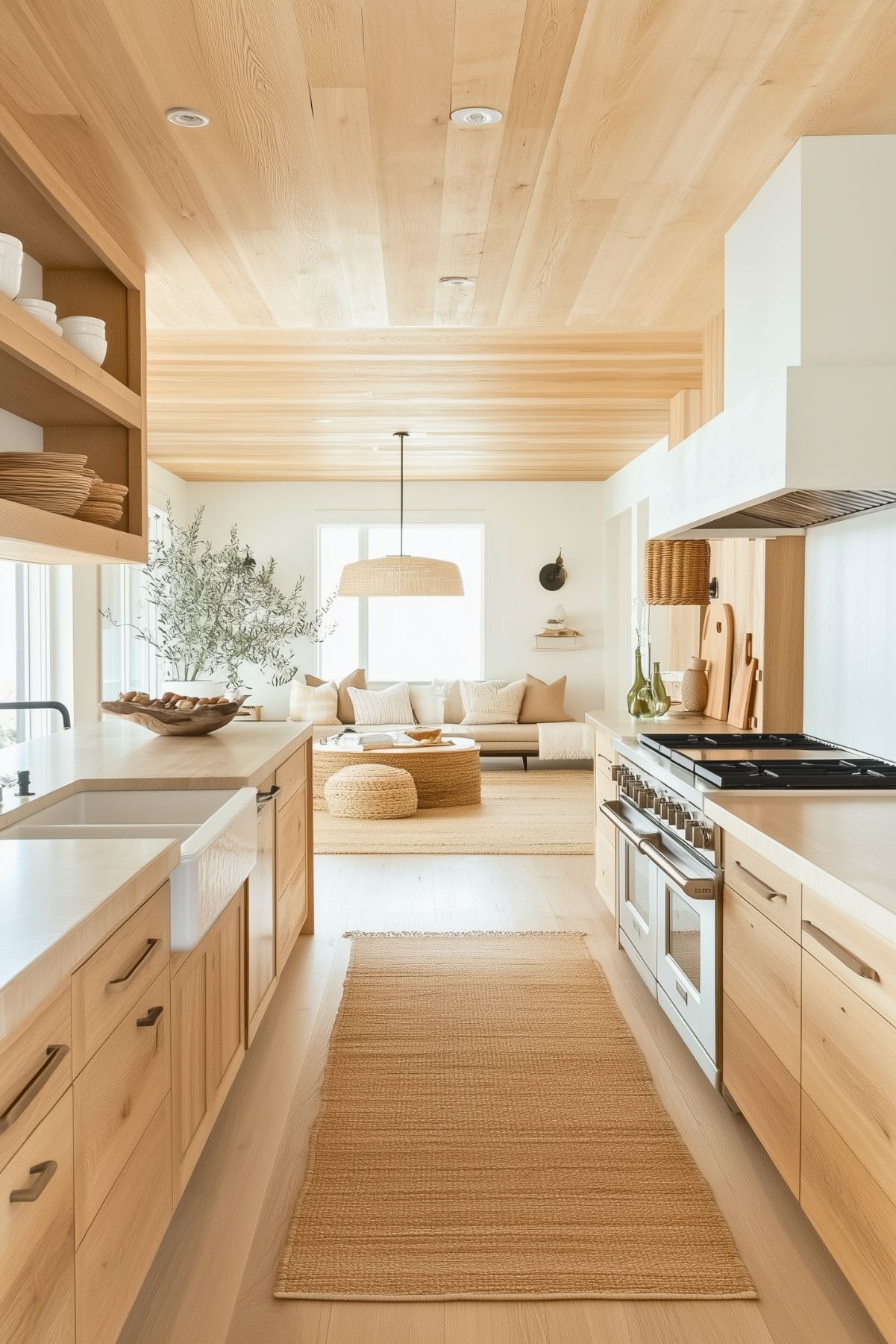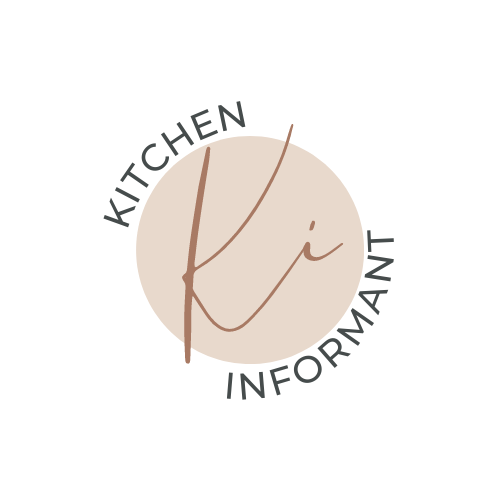Scandinavian kitchen design is known for its bright and airy aesthetic, making it a popular choice for homeowners who want a clean, minimalist look.
This style emphasizes functionality and simplicity, with a focus on natural materials and neutral colors.
If you’re looking to create a Scandinavian-inspired kitchen, there are several key elements to consider.
One of the most important aspects of a Scandinavian kitchen is the layout. It should be open and uncluttered, with plenty of natural light.
This means that you may need to make some changes to your existing space, such as removing walls or adding windows.
You’ll want to choose furniture and fixtures that are sleek and minimalistic, with clean lines and a focus on functionality over ornamentation.
Key Takeaways
- Scandinavian kitchens emphasize functionality and simplicity, with a focus on natural materials and neutral colors.
- The layout of a Scandinavian kitchen should be open and uncluttered, with plenty of natural light.
- Furniture and fixtures should be sleek and minimalistic, with clean lines and a focus on functionality over ornamentation.

Defining Scandinavian Kitchen Design
Scandinavian design is a popular style that emphasizes simplicity, functionality, and minimalism.
It originated in the Nordic countries of Denmark, Finland, Iceland, Norway, and Sweden in the early 20th century and has since become a global design movement.
Scandinavian kitchen design is characterized by clean lines, natural materials, and a neutral color palette.
Key Characteristics
Scandinavian kitchen design is known for its simplicity, functionality, and minimalism. The design style favors clean lines and natural materials such as wood, stone, and metal.
The furniture is often sleek, minimal, well-designed, and functional. The focus is on creating a bright and airy space with plenty of natural light.
Historical Influences
Scandinavian kitchen design has been influenced by the region’s long winters, which are characterized by short days and long nights.
The design style emphasizes the use of natural light to create a bright and airy space.
The harsh climate has also influenced the use of natural materials such as wood, which is readily available in the region.
Color Palette and Materials
The color palette of Scandinavian kitchen design is typically neutral, with white being the predominant color. Other colors such as gray, black, and beige are also used to create a sense of warmth and coziness.
Natural materials such as wood, stone, and metal are used extensively in Scandinavian kitchen design.
The use of natural materials helps to create a connection between the indoors and outdoors, which is an important aspect of Scandinavian design.
Planning Your Layout

When designing a bright and airy Scandinavian kitchen, planning your layout is key.
Here are some important factors to consider:
Maximizing Natural Light
One of the defining features of a Scandinavian kitchen is the use of natural light. To maximize the amount of natural light in your kitchen, consider the placement of windows and doors.
If possible, position your kitchen in a location that receives plenty of natural light. You can also consider adding skylights or light tubes to bring in even more natural light.
Functional Zones
A functional kitchen is essential in any home, and Scandinavian kitchens are no exception. When planning your layout, consider the different zones of your kitchen.
For example, you may want to create a separate area for food preparation, cooking, and cleaning. This will help to keep your kitchen organized and efficient.
Open Floor Plan Essentials
An open floor plan is another key feature of a Scandinavian kitchen. This allows for a seamless flow between the kitchen, dining, and living areas.
When planning your layout, consider how you can create an open and spacious feel. This may involve removing walls or creating a pass-through between the kitchen and dining area.
Selecting Furniture and Fixtures

When creating a bright and airy Scandinavian kitchen, selecting the right furniture and fixtures is essential.
Here are some key considerations to keep in mind:
Minimalist Cabinetry
One of the defining features of a Scandinavian kitchen is its minimalist cabinetry. Look for sleek, simple designs with clean lines and minimal ornamentation.
White or light-colored cabinetry is a popular choice, as it helps to reflect light and create a bright, open feel.
Consider choosing cabinets with integrated handles or push-open mechanisms to maintain a streamlined look.
Sleek Lighting Solutions
Lighting is another crucial element of a bright and airy Scandinavian kitchen. Look for fixtures that are sleek and simple, with clean lines and minimal ornamentation.
Pendant lights are a popular choice, as they can provide focused task lighting while also adding visual interest to the space.
Consider choosing fixtures with metal or glass shades, which can help to reflect light and create a bright, open feel.
Ergonomic Seating Options
In a Scandinavian kitchen, seating should be both comfortable and functional. Look for chairs and stools with ergonomic designs that support good posture and allow for easy movement.
Consider choosing seating with light-colored upholstery or natural materials like wood or leather, which can help to create a warm, inviting feel.
Avoid bulky or overstuffed seating, as this can detract from the clean, streamlined look of the space.
By keeping these key considerations in mind, you can select furniture and fixtures that will help to create a bright and airy Scandinavian kitchen that is both functional and beautiful.
Incorporating Color and Texture

Scandinavian kitchens are known for their bright and airy feel, achieved through the use of light colors and natural textures.
For color, neutral tones are the way to go. White is the most common color used in Scandinavian kitchens, as it reflects light and gives the illusion of a larger space.
Other popular colors include light shades of blue, yellow, and cream.
Neutral Tones
Neutral tones create a calming and inviting atmosphere in a Scandinavian kitchen. They also allow for flexibility in decorating and accessorizing.
White walls and cabinets are a great starting point, but adding touches of gray, beige, or even black can add depth and dimension.
Natural Wood Accents
Natural wood accents are an essential element of Scandinavian design, bringing warmth and texture to the space.
Wood can be incorporated into the kitchen in a variety of ways, from flooring to cabinets to countertops.
Light wood tones, such as birch and pine, are popular choices for Scandinavian kitchens.
Textile Variety
Adding textiles to a Scandinavian kitchen is an easy way to bring in color and texture. Simple, natural materials like linen, cotton, and wool are ideal for achieving the look.
Textiles can be used in a variety of ways, such as curtains, tablecloths, and dish towels. Bold patterns and bright colors can be used sparingly to add interest and contrast to the space.
By incorporating neutral tones, natural wood accents, and textile variety, one can create a bright and airy Scandinavian kitchen that is both functional and inviting.
Accessorizing Your Kitchen

When it comes to accessorizing your Scandinavian kitchen, there are a few key elements to consider.
By incorporating decorative elements, organizational tools, and greenery and plants, you can create a bright and airy space that is both functional and stylish.
Decorative Elements
One of the easiest ways to add visual interest to your kitchen is by incorporating decorative elements. This can include items such as artwork, decorative plates, and colorful dish towels.
When selecting decorative elements, it is important to choose items that complement the overall color scheme and aesthetic of your kitchen.
Another popular decorative element in Scandinavian kitchens is open shelving. By displaying your favorite dishes and glassware on open shelves, you can add a personal touch to your kitchen while also creating a sense of openness and airiness.
Organizational Tools
In addition to decorative elements, organizational tools are also important in creating a functional and efficient kitchen. This can include items such as drawer organizers, spice racks, and utensil holders.
When selecting organizational tools, it is important to choose items that are both functional and visually appealing.
For example, a set of wooden utensils can not only be used for cooking but can also add a touch of warmth and texture to your kitchen.
Greenery and Plants
Finally, incorporating greenery and plants into your kitchen can help create a sense of freshness and vitality. This can include items such as potted herbs, succulents, and hanging plants.
When selecting plants for your kitchen, it is important to choose varieties that thrive in low-light conditions.
Some popular options for Scandinavian kitchens include snake plants, pothos, and spider plants.
By incorporating decorative elements, organizational tools, and greenery and plants, you can create a bright and airy Scandinavian kitchen that is both functional and stylish.
Lighting Considerations

When designing a Scandinavian kitchen, it is important to consider the lighting options available. Proper lighting can help create a bright and airy atmosphere, while also providing functional illumination for cooking and other tasks.
Layered Lighting Design
One effective approach to lighting a Scandinavian kitchen is to use a layered lighting design. This involves using multiple light sources at different levels to create a balanced and well-lit space.
One option for layered lighting is to use overhead fixtures, such as pendant lights or track lighting, to provide general illumination for the room.
These fixtures can be supplemented with under-cabinet lighting, which can provide additional task lighting for cooking and food preparation.
Another option is to incorporate natural light into the design, using large windows or skylights to bring in sunlight and create a bright and open space.
Energy-Efficient Options
In addition to considering the design and placement of lighting fixtures, it is also important to choose energy-efficient options that can help reduce energy costs and minimize environmental impact.
One option for energy-efficient lighting is to use LED bulbs, which use significantly less energy than traditional incandescent bulbs and can last up to 25 times longer.
Another option is to use motion-activated or timer-controlled lighting, which can help reduce energy usage by automatically turning off lights when they are not needed.
By carefully considering the lighting options available and choosing energy-efficient solutions, it is possible to create a bright and airy Scandinavian kitchen that is both functional and environmentally friendly.
Implementing Smart Storage Solutions

Creating a bright and airy Scandinavian kitchen is not just about aesthetics but also about functionality. One of the key elements of a Scandinavian kitchen is smart storage solutions that can help maximize space and keep the kitchen organized.
In this section, we will discuss two types of smart storage solutions: innovative cabinet organizers and space-saving techniques.
Innovative Cabinet Organizers
In a Scandinavian kitchen, cabinets are not just for storage but also for displaying beautiful dishes and kitchenware.
To make the most of your cabinet space, consider implementing innovative cabinet organizers such as pull-out drawers, lazy susans, and sliding shelves.
These organizers can help you easily access items in the back of your cabinets and make the most of your vertical space.
Another innovative cabinet organizer to consider is a pegboard. A pegboard is a great way to keep your kitchen utensils organized and within reach. You can easily customize the pegboard to fit your specific needs and style.
Space-Saving Techniques
In a small Scandinavian kitchen, space-saving techniques are essential. One way to save space is to use the area above your cabinets for storage.
You can add floating shelves or baskets to store items that you don’t use frequently.
Another space-saving technique is to use a rolling cart or island. A rolling cart or island can provide extra counter space and storage without taking up too much room.
You can also easily move the cart or island around the kitchen as needed.
Finally, consider using the inside of your cabinet doors for storage. You can add hooks or racks to the inside of your cabinet doors to store items such as pot lids and cutting boards.
By implementing these smart storage solutions, you can create a functional and organized Scandinavian kitchen that maximizes space and looks beautiful.
Maintaining a Clutter-Free Space

Creating a bright and airy Scandinavian kitchen requires maintaining a clutter-free space. This means that every item in the kitchen should have a purpose and a designated spot.
Keeping the space organized and tidy will not only make the kitchen look visually appealing but will also make it easier to navigate and use.
Regular Cleaning Tips
One of the easiest ways to maintain a clutter-free space is to clean the kitchen regularly. This means wiping down countertops, sweeping the floors, and washing dishes after each use.
By keeping the kitchen clean and tidy, it will be easier to spot items that are out of place and put them back in their designated spot.
Another cleaning tip is to declutter the kitchen regularly. This means getting rid of items that are no longer needed or used.
It’s easy for kitchen items to accumulate over time, so it’s important to go through the kitchen periodically and get rid of anything that is not essential. This will help keep the kitchen organized and clutter-free.
Minimalist Mindset
Adopting a minimalist mindset is key to maintaining a clutter-free space in the kitchen. This means only keeping items that are essential and getting rid of anything that is not needed.
When designing a Scandinavian kitchen, it’s important to focus on function and practicality rather than aesthetics.
One way to adopt a minimalist mindset is to invest in multi-functional kitchen items. For example, a cutting board that doubles as a serving platter or a set of mixing bowls that can be nested together to save space.
This will not only help keep the kitchen clutter-free but will also save money and reduce waste.
Final Touches

Personalizing Your Space
While Scandinavian design is known for its minimalism, it’s important to add personal touches to make your kitchen feel like home.
Consider adding a few decorative items, such as a vase of fresh flowers or a piece of artwork, to add warmth and personality to your space.
You can also add texture with a cozy rug or a few throw pillows on your seating area.
Another way to personalize your space is by incorporating plants. Plants not only add a touch of greenery to your kitchen but also help purify the air.
Consider adding a few potted herbs or hanging plants to your windowsill or shelves.
Quality Over Quantity. In Scandinavian design, less is more.
Instead of filling your kitchen with unnecessary items, focus on quality over quantity. Invest in high-quality cookware, utensils, and appliances that will last for years to come.
Not only will they look great in your kitchen, but they will also make cooking and baking a breeze.
For furniture, choose pieces that are functional, comfortable, and timeless. Opt for simple designs with clean lines that will stand the test of time.
Remember, a clutter-free kitchen is a happy kitchen.
By following these final touches, you can create a bright and airy Scandinavian kitchen that is both functional and inviting.
Frequently Asked Questions

What are the essential elements to include in a Scandinavian kitchen design?
A Scandinavian kitchen design is all about simplicity, functionality, and minimalism. The essential elements to include in a Scandinavian kitchen design are clean lines, natural materials, and a neutral color palette. The use of light-colored wood, such as pine, birch, or ash, is a hallmark of Scandinavian design. Open shelving, simple cabinetry, and plenty of natural light are also important elements to incorporate.
How can I incorporate a Scandinavian aesthetic into a small kitchen space?
Incorporating a Scandinavian aesthetic into a small kitchen space can be a challenge, but it is possible. One way to do this is to keep the design simple and minimalistic. Use light colors, such as white or pale gray, to make the space feel larger and brighter. Open shelving and simple cabinetry can also help to create a sense of openness. Consider using mirrors or reflective surfaces to bounce light around the room and create the illusion of more space.
What color schemes are typically used in Scandinavian kitchen designs?
A Scandinavian kitchen incorporates a limited color palette. Whites and neutral hues blend with light, natural wood tones, while pops of blue and green bring the colors of the outdoors inside. The use of light colors helps to create a bright and airy feel, while the natural wood tones add warmth and texture. When choosing colors for a Scandinavian kitchen design, it is important to keep the palette simple and understated.











You May Also Like:






